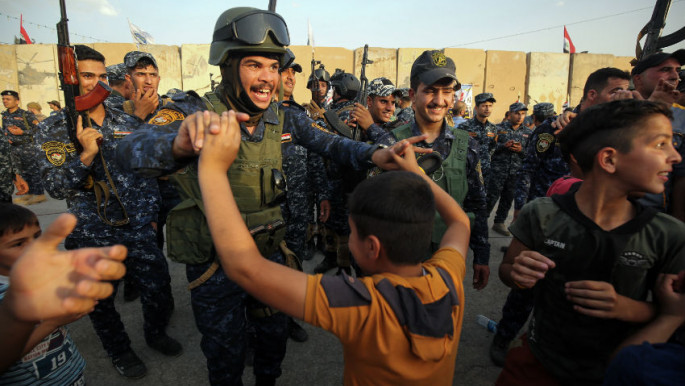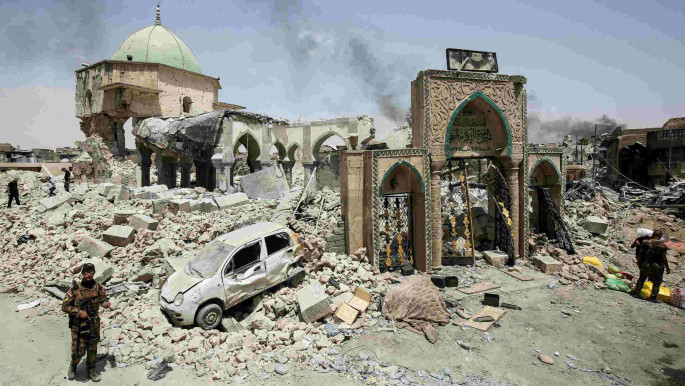The Iraq Report: Battle for Mosul drags on
Click here to receive The Iraq Report each week in your inbox
While Iraqi Prime Minister Haider al-Abadi has declared victory in the battle for Mosul, announcing that the forces of the Islamic State group have been defeated, the Iraqi military and allied Federal Police units are still locked in a bloody struggle against the militants. IS have continued to bleed their opponents, and despite Iraqi politicians’ celebrations on Twitter, the battle is far from over.
In other parts of Iraq, Iran has started to manoeuvre itself and its proxies in order to gain greater control over parts of the country close to Tehran’s borders. Iran’s efforts may be seen as part of its widely reported bid to establish a land corridor that traverses Iraq and Syria, and connects to Lebanon, currently under the influence of Lebanese Shia militant group Hizballah. This has emboldened Shia Islamist armed groups to continue their murderous campaign – and not even fashion models are safe.
Fighting in Mosul grinds on
Iraqi troops filmed themselves in the ruins of the Grand Nuri Mosque, recently destroyed in the fighting. The Iraqi government, led by the prime minister, took the opportunity to issue statements over social media, declaring victory over IS and announcing that its “caliphate” had been destroyed.
Abadi posted: “We are seeing the end of the fake [IS] state, the liberation of Mosul proves that. We will not relent, our brave forces will bring victory.” However, many have questioned whether Abadi’s announcements can be anything more than public relations stunts. The Economist wrote on 30 June that Iraq had claimed “a slightly premature victory over Islamic State”.
Although Lieutenant General Abdulwahhab al-Sa’idi was reported on Sunday as saying that IS defences in the Old City had “collapsed”, IS still holds stretches of territory in Mosul’s Old City near the Tigris River where the fighting has been particularly brutal. The militants have also continued to demonstrate an ability to strike deep into apparently already recaptured areas, with IS suicide bombers managing to kill senior Popular Mobilisation Forces (PMF) commanders as recently as late on Monday night.
IS’ continued ability to launch deadly attacks, while slowly drawing Iraqi forces to attrition in Mosul’s Old City, shows that the battle is ending - but it is far from over, as the fighting nears its ninth month. Even when the fighting eventually ends in Mosul, IS still holds territory in Tal Afar to the west, Hawija to the east, and other patches of the Iraqi desert. Without a political solution that fully incorporates Iraq’s long-persecuted Sunni Arab demographic while isolating pro-Tehran Shia extremists, Baghdad will lack the local support it needs to root out the militants.
 |
| The celebrations: Iraqi federal police officers dance with children as the battle in Mosul nears an end [AFP] |
Civilians killed both by IS and Iraqi forces
While IS’ brutal methods of gunning down civilians fleeing the fighting have been reported and well documented, the tactics used by Iraqi forces and the allied US-led coalition have also been called into question, raising issues of human rights abuses and the mass destruction of civilian infrastructure without military need.
Human Rights Watch reported last Friday allegations that Iraqi forces were witnessed beating unarmed men and boys who were attempting to flee the carnage around them in Mosul. HRW said that “while Iraqi forces are promising liberation”, members of the Emergency Response Division – a unit of the Federal Police already embroiled in war crimes allegations – had boasted to one witness they were killing men and boys fleeing the city, suspecting them of being IS fighters.
Witnesses told HRW that these abuses and murders were perpetrated not only by groups affiliated with the Federal Police – who are controlled by the pro-Iran Badr Organisation – but that they also heard screams of men allegedly being tortured in buildings occupied by the elite Counter Terrorism Service (CTS), part of the Iraqi army.
American network ABC News reported in 2015 that the US-funded and trained CTS was perpetrating abuses primarily against Iraq’s Sunnis. Their actions were so notorious that they were dubbed the “Dirty Brigade” by the media for their brutality. Although they have recently undergone something of a PR facelift, their alleged involvement in these latest abuses harkens back to their earlier atrocities, and risks upending years of trying to clean their public image.
Airwars, an organisation that monitors US-led coalition airstrikes and civilian casualties, has said that “thousands of Moslawis have credibly been reported as killed since October 2016”. According to the monitor, the coalition fired 29,000 munitions into Mosul, with the civilian deaths on the west bank five times higher on than the east bank of the city. This demonstrates the increasingly ferocious nature of the assault in Mosul, with grim consequences for civilians.
Kurdish media outlet Rudaw released haunting drone footage showing the mass destruction that had been inflicted upon Mosul during the past year. The footage serves as a stark reminder of the reality faced by the population not only in Mosul, but other recaptured cities reduced to rubble, such as Ramadi, Fallujah, Tikrit and others. If Baghdad fails to redevelop and reintegrate not only these cities but their populations, the fight against IS may end - only for a new war to begin.
Iran launches operations inside Iraq
Iran has begun to coordinate with its proxies in Iraq to launch a military operation in Iraq’s eastern Diyala governorate which shares a border with Iran. Tehran has long said that it would launch operations directly into Iraq in coordination with its allies if IS came within 40 kilometres of its borders. However, there are fears that Iran is using IS as an excuse to purge Diyala of “undesirable” populations, particularly Sunni Arabs and Turkmen.
Diyala has suffered at the hands of Iranian-backed, Baghdad-sanctioned Iraqi Shia militias, particularly the PMF, known in Iraq by their Arabic name, the Hashd al-Sha’abi. Extremist Shia militants have been known to raid major provincial cities such as Baquba, and literally string Sunni men and boys up on lamp-posts as a warning to other inhabitants. When IS first burst into global headlines in the summer of 2014, Baquba’s mayor revealed that Shia militias had murdered more than 40 prisoners in cold blood in revenge killings.
 |
| The aftermath: CTS officers survey the remains of the Nuri Mosque in Mosul [AFP] |
Iran’s latest endeavour is feared to be similar to efforts in Samarra in central Iraq’s Salahuddin governorate. Samarra, famed for its iconic spiralling Malwiyah Mosque, is a predominantly Sunni Arab city. In 2016, Al Jazeera reported Samarra was subject to a sectarian cleansing campaign by Iran-backed forces - with the knowledge and acquiescence of the Iraqi government. Locals were threatened into leaving their homes, and brutal recriminations lay in store for any in Samarra who failed to heed them.
By clearing out populations seen as unfriendly to Iranian ambitions from regions close to Iran’s borders – including Sunni-dominated Salahuddin and Diyala –Tehran is ensuring that there will be no population centres that may disrupt its now widely reported land corridor bridging Iran to Lebanon and Syria’s Mediterranean coasts through Iraq.
Persecution and murders
Meanwhile, the Iraqi government has been implementing a new law against predominantly Sunni Arab families in Mosul and other cities, similar to the US-instituted “de-Ba’athification” law in 2003 – a law that has been criticised as being used to silence any political dissent. Baghdad is using the “Daesh families” bill to expel and ostracise families of IS fighters.
Since the US-led invasion in 2003, Iraq has been wracked not only by violence, but also rife corruption and a heavily politicised judiciary. With a lack of a sufficiently robust justice system risking “witch hunt” type trials where scores are settled by accusations of being an IS member or sympathiser, the new Iraqi law could be devastating for communities. Not only will the accused be exiled from society, but their entire family will be too - with frightening results for human rights in Iraq.
Iraq’s continuing slide into lawlessness has hit not only ethno-sectarian groups, but even those involved in the arts. Actor Karrar Noushi was abducted before later being found murdered in Baghdad on Sunday, allegedly having been killed for his good looks. Armed Shia Islamist groups have been known to kill Iraqis accused of homosexuality, and were even known to kidnap Iraqi teenagers with emo haircuts, smashing their heads between bricks. The spate of “emo killings” in 2012 followed a statement released by the hardline Shia Islamist Badr Organisation-controlled Interior Ministry which described the “emo phenomenon” as “devil worshipping”.
With Noushi’s murder demonstrating that these killings continue to be a trend in Iraq, fears will undoubtedly increase that Shia fundamentalism akin to Iran’s theocracy will ultimately relegate Iraq’s democracy to a continued position of inferiority, as armed religious gangs continue to dictate not only political actions, but also societal standards.
Click here to receive The Iraq Report each week in your inbox
Follow us on Twitter: @the_newarab



